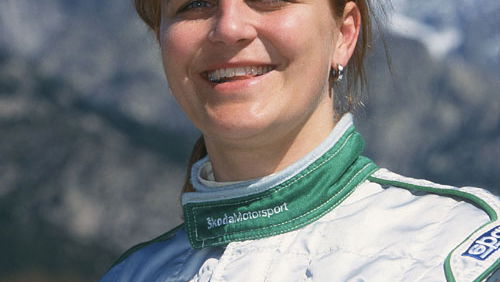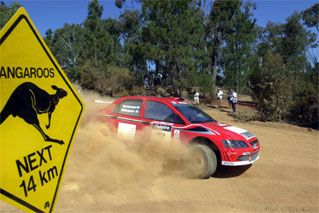Q&A: Tina Thorner.
The world of motorsport is still by and large an environment controlled by and competed in by men. But there is one motorsport discipline where women, although rare, are holding their own at the very top competitive level.
That is the World Rally Championship, where women, although still in a very tiny minority, have for many years proved themselves able to compete at the very top echelons of the sport.

The world of motorsport is still by and large an environment controlled by and competed in by men. But there is one motorsport discipline where women, although rare, are holding their own at the very top competitive level.
That is the World Rally Championship, where women, although still in a very tiny minority, have for many years proved themselves able to compete at the very top echelons of the sport.
This season Skoda Motorsport has a line up never before seen in the sport. For 2002 the team can boast not just one woman co-driver on the team, but two - Tina Thorner, who co-drives for Kenneth Eriksson and Ana Goni who is the co-driver of the former World Champion, Stig Blomqvist.
Together they represent a unique phenomenon, women who have worked their way to the very top of the sport in spite of the many additional barriers that their sex has put in their way.
Tina Thorner was born 80 kilometres from the famous HQ of the Swedish Rally, Karlstad. She is one of the most popular characters in rallying, not least because she is such a team player. Being part of a team is a valuable asset for rallying, one she learnt growing up on a farm with her two sisters and five brothers.
Here Tina gives her personal views on rallying, fear and whether men are better drivers than women.
Q:
You cope really well with all the hard work a rally entails. What makes you so good at this?
Tina Thorner:
When I was 11, I had my own 100 hens. Being on a farm we got used to always helping out and working together. Our parents were also working very hard, seven days a week, 365 days a year, so I learnt the value of hard work and being independent. When I was 14 I was bitten by a passion for flying, I got my first licence at 15 and was the first girl ever to apply to join the national Swedish airlines, SAS, training programme. I was not really interesting in co-driving, but then someone asked me if I could co-drive for them. I simply thought it would be fun and I thought why not. I was 18 at my first rally.
Q:
Did you have to make any tough choices to get to where you are now?
TT:
I graduated in 1989 with a degree in economic studies and marketing and was immediately offered a very good position, with a good salary and prospects, for a PR firm. But as soon as I accepted the job, I was also offered the chance to co-drive British driver Louise Aitken-Walker. It was a terrible dilemma. The job was great, but I also had this great opportunity. I asked my boss if I could take the time off for the rally, but he, quite rightly, said Tina, we don't pay you to go off rallying. So I had to make a decision - and quickly. I had 15 seconds to make up my mind. So I thought to myself, 'Tina you can always sit behind a desk'. And I decided there and then that I wanted to be a co-driver. I called my father and said dad don't bother about buying me that apartment you were planning for me. He asked why not and I said I have just quit my job. He was quite calm, but not very happy and just said, okay, if that's what you want, but from now on you make your own way in life.
Q:
It doesn't sound like your family 'approved' of your decision. Is that right?
TT:
My father never approved of rallying but mainly because he did not understand it. Then I was amazed because at the last Rally of Sweden he turned up at a team presentation we did at the Skoda dealership. I did not know he was coming. But then I am helped by the fact I am Kenneth's co-driver. He has always admired and respected Kenneth, so perhaps now finally he is getting used to the idea.
Q:
You have made a lot of sacrifices for motorsport. Why have you done this and what sacrifices have you made?
TT:
I certainly hope what I am doing will make it easier for other girls to enter the sport. They can see that there are such possibilities in rallying. That it is a good job and we can be respected. But it is necessary to set aside a lot of things in your life. The biggest sacrifice is undoubtedly children and a family. You cannot co-drive for nine months with a big belly and then leave the babies at home. Men have it easier because they can leave their children at home with their wives. I have never wanted children, so it has been ok for me. But even in your personal life you have to make sacrifices. I have a boyfriend and I am very busy so it is often the case that I just have no time for him. But he is in the business as well. He is racing driver and so he understands me and the life. In the beginning you think you can have a personal life and rally, but gradually rallying takes over your life and you realise it isn't possible to have both.
Q:
Who are better drivers, men or women?
TT:
Men are, because it is easier for them. Men are naturally bigger risk takers, while women consider the consequences. Also women have less experience of driving. So many men start playing around with cars and skidding them and everything when they are very young. So they are used to it. But women do not grow up with the same experiences. When we talk about driving as a sport, there is another problem - pressure. It is too great in sport like this. You have to be able to take the pressure. You have to be very secure in yourself. You are like an entrepreneur. You take risks and look after yourself. I think it is another advantage for men.
Q:
Is fear a problem for you? - Motorsport is after all a dangerous sport...
TT:
You fear for accidents all the time. For example during the last rally in Sweden, we came over the crest of a hill at around 195 kph and we suddenly had people around the car. You go cold inside because you think you will hurt someone. Lucky we didn't. But my worst accident was in 1999 when the car left the road, we fell hundreds of feet down a cliff and into water. We were trapped under five metres of water. You know you have just seconds. I sat in the car and I thought to myself this was it, I was going to die, I could not get my door open because it had been crushed by the accident. Then I somehow managed to crawl out of the rally cage; to this day I don't really know how. The crash was so serious I lost my sight for a while. But I had to go on. I was back in the car as soon as I was able and then driving for 15 days solid around Corsica, so that dealt with any fear I had.
Q:
Why did you have to go on? - You could have stopped if you felt the risks were to great.. Is this part of the thrill of rallying?
TT:
Maybe it is that I simply like taking risks. For me the thrill of rallying is pushing yourself to the limit and experiencing the thrills as you exceed that limit. Also I like rallying because it is the perfect combination of man and machine, working together, working hard to get the best possible results.
